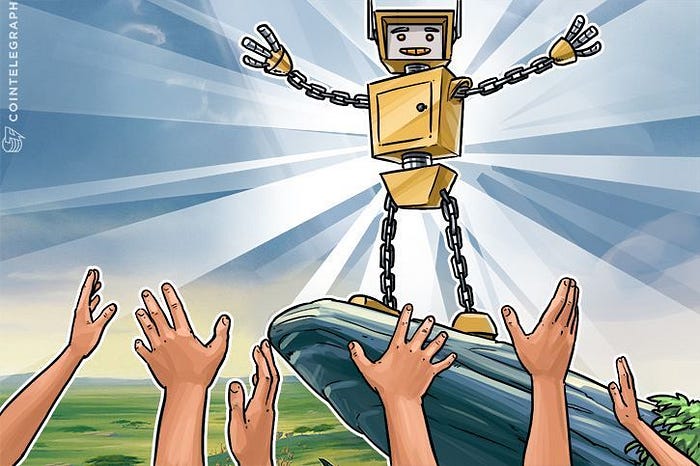Also check out Blockchained Society: A series of storytelling articles that zoom in on possible applications of blockchain technology. PART 1 | PART 2 | PART 3 | PART 4 | PART 5 | PART 6

Ever since the Bitcoin hype-train started rolling, friends and family have increasingly been asking me questions regarding blockchain and cryptocurrencies. Since it’s quite hard to explain the core concepts of the technology in a few minutes; I decided to start writing about it.
For the next few weeks, I’ll be writing about blockchain technology and noteworthy projects. This very first article is all about introduction to the blockchain technology and its potential, and I’ve tried to keep it simple!
“Deniz, what is blockchain? Can I eat it?”

No, you cannot eat a blockchain but I do think it’s one of the biggest technological innovations since the internet, which will impact lots of industries. The first working application of blockchain technology was Bitcoin, which was launched in 2008 and was originally meant as an electronic payment system without a central authority. Though Bitcoin was a revolutionary concept, the potential of the technology far exceeds digital money. These days there are tons of cool projects utilizing blockchain technology; most of them way more interesting than Bitcoin.
“Okay, but what problem does it try to solve?”
The problem that blockchain tries to solve is digital trust. With the internet, we can share anything with anybody, but we’re actually just sending each other copies. This is fine for family pictures and cat videos, but what if I want to send you something that should not be copied? When I send you a concert ticket or digital coins; how can you be sure that I no longer possess what I’ve just sent you? Right now, we use trusted third parties to make sure we don’t “double spend”. For example: Banks manage our account balances, so that I can’t spend the exact same €100 euro twice and Ticketswap makes sure that I can’t use my concert ticket after selling it.
“But we have all these third-parties to solve these problems… Why should we change the current system?”

The answer to that question can be read in the news every single day: Third parties can be fraudulent, their employees can make mistakes, their servers can be hacked and most of all: they are usually very inefficient. What if we could just handle everything ourselves — sender and receiver — without all these middlemen? That’s one of the promises of blockchain: a decentralized society.
“I guess blockchains are pretty cool then. But what exactly are we talking about? Is it a new type of smartphone?”
A blockchain is a data structure. Imagine it as some kind of a global database without central ownership and without central servers. Instead, everyone on the network owns an exact copy of the data and can request changes to it. The data is only changed when most of the participants in the network agree with the change. Different blockchain platforms may use this “global database” in various ways. One of the simplests forms is Bitcoin’s blockchain, which is basically an ever expanding list of bitcoin transactions (ie. a digital ledger)
“So everyone owns a copy of the whole database? Isn’t that super inefficient and impossible?”
Great question! This is why — for now — we don’t want to store everything on a blockchain, but only “sensitive” data (data that should be impossible to change without all other stakeholders agreeing with the change). Sensitive data might be related to identity, ownership, money transactions, provenance, etc.
In the near future, blockchain might be able to store and process huge files, such as 4K movies and online video games. There is a lot of development going on concerning blockchain scalability, but I won’t go into detail here.
“Okay, I think I’m getting the hang of it! What about security; why is a blockchain more secure than a centralized database?”
As I mentioned before: Every participant of a blockchain network owns a copy of the database. When a participant wants to change something in the database — for example, by creating a new transaction — this change is broadcast to all other network participants and is only accepted when the majority agrees on its validity. This makes it very hard to apply fraudulous changes to the database, since it would create a discrepancy with the rest of the network and they would deny the change.

And here’s also where the “block” in blockchain comes in. Every few minutes; all new transactions are bundled together in a “block” and protected by cryptography. This block is then added to the previous block, which is linked to the block before that, and so on. This creates a rock-solid and ever-expanding record of database changes, which becomes increasingly harder to tamper with as the “blockchain” grows longer.
“This all sounds very promising! The only thing I don’t understand is why we need cryptocurrencies for this. Why the hell do people pay thousands of dollars for a bitcoin?”

Just like the “fiat currencies” we all know and use; cryptocurrencies are a medium of exchange. Every crytocurrency can be programmed to have its own intrinsic value within its network. For example, you need Ether (ETH) to make use of the Ethereum blockchain and banks need Lumens (XLM) to transact with the Stellar blockchain. Cryptocurrencies can also be programmed to be scarce. In the case of Bitcoin; there will never be more than 21 million bitcoins, which is why some regard it as “digital gold”.
By owning a cryptocurrency, you basically own a part of the network and effectively invest in its potential. These days, however, the market value of most cryptocurrencies are highly inflated by speculation and do not represent the actual value of the underlying projects. Later on, I’ll write more about the concept of cryptocurrencies and the practice of investing in them.

You’ve managed to read through this; impressive! I hope this helped you grasp the core concepts of blockchain technology, because I truly believe it will be one of the driving transformative forces to our society as we know it today. I’d love to hear your feedback below, even if it’s just by clapping.
This is the first in a series of articles regarding blockchain tech and crypto projects. I’ll be writing more on potential use cases and interesting projects that are in development.
Feel free to hit me up when you have questions or curiosities regarding blockchain and crypto; I’m happy to help!
Peace and love.
Deniz
